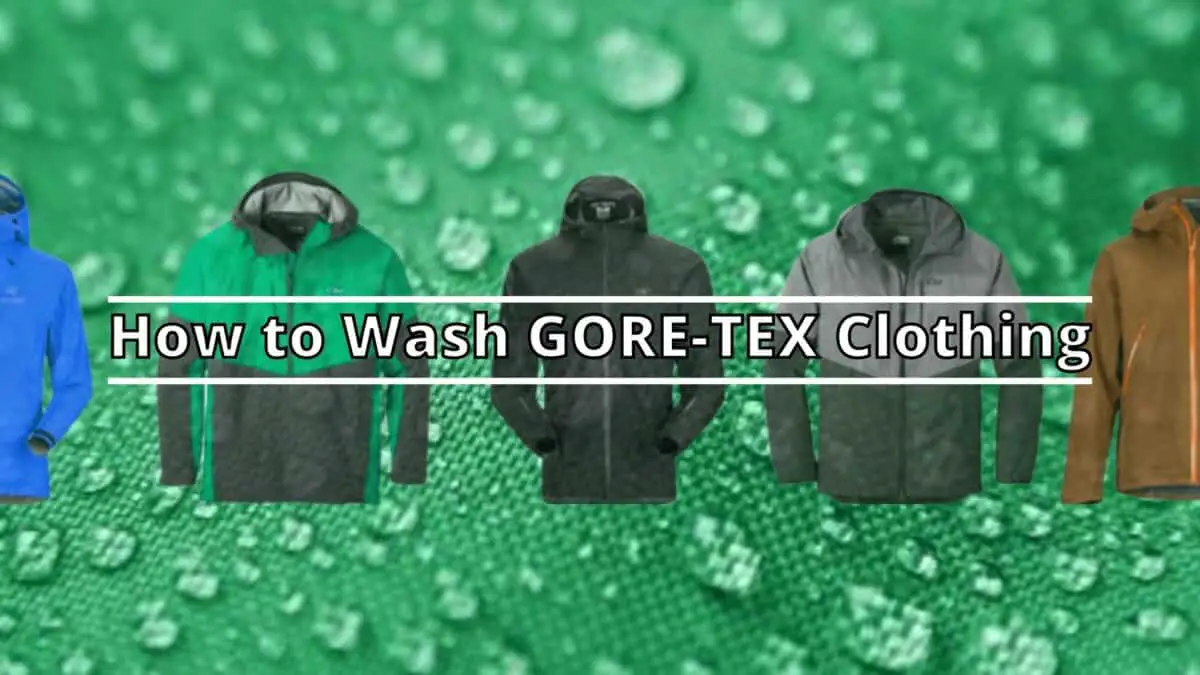Gore-Tex is a waterproof, breathable, patented fabric that is known for its high-performing weather protection. A strong and microporous expanded polytetrafluoroethylene membrane is the foundation of Gore-Tex fabric, and is bonded with durable outer fabrics for durability and abrasion resistance. It is a high-performing fabric, which thus needs to be taken care of.
To wash Gore-Tex clothing, use warm water and a small amount of liquid detergent and machine wash on a gentle cycle. Rinse twice, and avoid washing with heavily soiled clothing. Also, avoid the use of bleach, and other harsh detergents.
Washing Gore-Tex fabric may sound like a piece of cake, but there are numerous factors you have to consider to do so. Read along to know more on how to properly care for this type of fabric.
Things you’ll need
- A washing machine
- Liquid detergent
- A dryer
- Iron/towel/cloth (optional, if no dryer)
- Water-repellent treatment (as needed)
How to wash Gore-Tex clothing
- Zip the front closure, pockets, and vents or pit zips.
- Fasten all loose flaps and straps.
- Wash in your washing machine, or hand-wash in warm water.
- Machine-wash your Gore-Tex clothing on a warm permanent press cycle of 105°F/40°C, and add a small amount of liquid detergent.
- Rinse twice, and minimize spinning, as it will cause creasing.
- Do not use powder detergent, products with fabric conditioners, softeners, stain removers, and bleach, as these will affect the fabric’s performance.
- Do not wash together with heavily soiled garments.
Stain removal
- Use the same liquid detergent you would use to wash your Gore-Tex clothing.
- Rub an adequate amount of detergent onto the stained area.
- Run the clothing through a pre-wash cycle before laundering it.
- If your washing machine has no pre-wash cycle, rub the detergent onto the stained area, and pre-soak the garment instead.
How to dry Gore-Tex clothing
- Line dry or tumble dry using a warm and gentle cycle.
- Do not dry at high temperature.
- Once the clothing is dry, tumble dry for another 20 minutes to reactivate the durable water-repellent treatment.
- If you do not have a dryer, iron the clothing on a gentle setting that is warm with steam-free, and protect it by using a towel or cloth, and place it between the garment and the iron.
- Repeat steps if you need to boost its water repellency.
Note: If professional dry cleaning is necessary, then request the use of clear distilled hydrocarbon solvent for rinsing. After that, spray DWR treatment on the clothing’s outer fabric before drying. Always follow the manufacturer’s care instructions.
Re-apply water-repellent treatment
If you notice that water does not bead and roll off the garment after washing it, you need to re-apply a DWR treatment.
- Use the durable water-repellent product of your choice. You can opt for a pump-spray (recommended) or wash-in product.
- Follow the manufacturer’s application instructions, and tumble dry the clothing for about 20 minutes to activate the treatment.
- If you have no dryer, iron the dry clothing on a warm and steam-free setting. Remember to put a towel or cloth between the iron and the garment.
Note: Do not apply a durable water-repellent treatment to a Gore-Tex clothing that has a persistent beading surface.
A life jacket is an essential gear for anyone who wants to enjoy water activities, especially those who are not excellent swimmers. Picking a life jacket may seem easy, but there are different factors that you need to consider before you make your choice. Read our article to know how to choose the right life jacket.
Special care for Gore-Tex clothing with persistent beading surfaces
These garments are slightly different because they have no textile exterior layer. They only have a Gore-Tex membrane, thus, there is no need for a DWR treatment.
- Machine-wash on a delicate cycle setting at 105°F/40°C.
- Do not dry clean, and do not tumble dry these types of Gore-Tex clothing,
- Don’t iron these garments.
- Do not use bleach.
- Do not apply a Durable Water-Repellent (DWR) treatment, because they have no textile fabric.
Leaks
If you notice any significant moisture in or on your Gore-Tex clothing, there may be a leak or a more serious problem. A defective seam or a damage to the fabric are possible causes.
Dry cleaning
Some Gore-Tex fabric makes use of silk or wool, and most of these garments have care instructions that dictate the need to be dry-cleaned.
When dry-cleaning Gore-Tex clothing:
- Request a clear, distilled solvent rinse and a spray repellent.
- After dry-cleaning, re-activate the DWR treatment in a dryer on a low setting for 20 minutes.
Note: If the care instructions dictate not to use a dryer, then just use a warm iron, no steam, and place a thin cloth between the garment and the iron.
Salt water and Gore-Tex clothing
You do not have to worry about sailing, paddling, and cruising, because salt water does not have the ability to contaminate, clog, decrease breathability, or overall harm Gore-Tex fabric. However, to keep salt from accumulating and attracting water, simply rinse your Gore-Tex clothing occasionally in fresh water. Or rinse in seawater to reduce heavy salt accumulation.
Gore-Tex gloves
To wash Gore-Tex gloves, it is important to follow the manufacturer’s care instructions.
- Wash in machine or hand-wash in warm water.
- Squeeze from the fingertips to the wrist to remove excess water.
- Do not twist when removing excess water.
- Do not use chlorine bleach, as it may damage the gloves.
- For stains, use a pre-wash treatment, and follow the instructions. Rinse well.
- Drip-dry your gloves with the fingers facing upwards.
- Do not iron.
- Apply a topical durable water-repellent treatment.
- The use of wash-in treatment is not advisable, as it can affect the gloves’ breathability.
A wetsuit may come as a huge investment, which is precisely why proper care and maintenance is needed to make it last for many years. If you don’t know how to do this, read our article to learn how to wash a wetsuit.
FAQs
How often should I wash Gore-Tex clothing?
Wash your Gore-Tex clothing as often as you need to. This way, you can remove impurities such as dirt, cooking odors, or even smoke.
Washing, drying, and reheating Gore-Tex fabric helps in restoration of its durable water-repellent (DWR), which is important to the performance of a GORE-TEX garment.
What cycle should I use if I do not have a permanent press setting on my washing machine?
In this case, you can use a gentle cycle that does not spin the garment harshly. Reduce the spinning at 400 rpm or lower to minimize creasing.
Which is best, powder or liquid detergent?
It is recommended to use a liquid detergent instead of a powder detergent for best results.
How much laundry detergent should I use?
It is recommended to use 1 ounce or 30ml per load, depending on the local water quality.
Should I wash my Gore-Tex clothing by itself?
You can wash Gore-Tex clothing with similar garments that are not heavily soiled. A second rinse cycle is advisable to make sure that the detergent is completely rinsed off.
What is the best way to dry Gore-Tex clothing?
It is advisable to line-dry Gore-Tex clothing to reduce your impact on the environment by using less energy. Once the fabric is dry, tumble dry for 20 minutes to reactivate the DWR treatment. Remember not to tumble dry Gore-Tex Shakedry products.
Can I use an aerosol DWR spray?
Yes, an aerosol spray can be used, but it is more advisable to use pump-sprays to reduce your impact on the environment.
Can I use a home dry-cleaning kit on Gore-Tex fabric?
We do not recommend using home dry-cleaning kits. And if dry-cleaning is necessary, it is best to have a professional dry-cleaner use clear, distilled hydrocarbon solvents to rinse the fabric.
Can I iron Gore-Tex fabric?
Always check the manufacturer’s care instructions about the use of an iron. It is suggested to use an iron on low temperatures, and with no steam. Remember to put a thin cloth between the iron and garment, so that the heat will not directly touch the fabric.
Conclusion
When it comes to your equipment, whether it may be your gear or your clothing, it is important that you care for and maintain them properly to make them last longer. When it comes to your clothing, the way that you wash it will depend on its material.
When it comes to Gore-Tex clothing, it is important that you follow the manufacturer’s wash instructions in order to preserve the quality of your clothing. In addition to that, you can also follow the tips and tricks that we shared to keep your Gore-Tex clothing in tip-top condition.

